All profits to

Archive Home Page
Previous Exhibition Following Exhibition
St. Margaret's Hall, Coniston Road, Hatherley, Cheltenham, GL51 3NU
All profits to |  |
Descriptions are based on material supplied by the layout owners
Canada Road Canada Road models the era before docklands became smart executive homes and attractive waterside theme pubs ... It is somewhere between 1960 and the late 1970s, on the fringes of a major port. Worn down black steam engines are reaching the end of their days, green diesels have arrived but are soon swept away by a tide of corporate blue paint - the colour of trains from my teens. Soon all shunting nationwide will be handled by the universal Class 'O8', but not quite yet. The small exchange sidings just off Canada Road are visited by a variety of mixed traffic locomotives working to and from the local large marshalling yard. Occasionally larger locomotives are rostered, looking a little out of place on only a short string of wagons. The shunting engine then sorts the arriving trains, often taking short 'trip' workings out to the nearby industry and wharves. Sometimes the loaded trucks will be checked on the weighbridge before onward movement. The region and period of the scene change throughout the day, showing the many local types of diesel shunter which used to be found around the country. The changes in railway livery and traffic between the years 1960 and 1979 are portrayed. More than twenty types of shunting and mainline diesel locomotive appear, along with over forty different designs of wagon from the British Railways era. |   | |
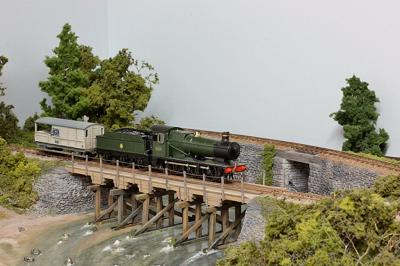 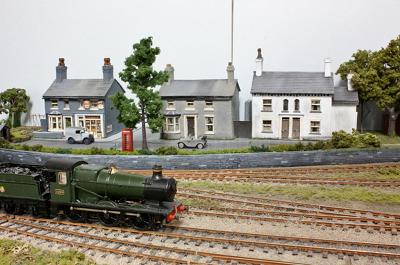 |
Glaslyn Junction is my attempt to portray the beautiful Cambrian Coast line in Wales in the 1950s and 60s. It is a fictitious place, set somewhere in the Porthmadog area and features a typical Cambrian line wooden trestle bridge. The branch line leads to another fictitious place, Caergwyddno, which is bound up in Welsh myths and legends! 3mm Scale (formerly known as TT) is much under-rated these days, and I hope this layout shows its potential, being larger than N Gauge (2mm) but smaller than 00 (4mm), giving the modeller the opportunity to create a fair amount of railway in a reasonable space. The baseboards are constructed from plywood on a softwood framework and a cassette system is used in the "Fiddle Yards" at either end. The buildings and structures are scratchbuilt mainly from card or DAS modelling clay, and then painted with watercolour or acrylics. Scenery is by Woodland Scenics including the River Glaslyn for which their "Realistic Water" was used. Locos and Rolling Stock are mainly kitbuilt and many can be obtained from the 3mm Society. | |
Gorpeton Blymee Gorpleton Blymee represents a GWR branch line at the end of the Company's existence in the late 1940's just as the new British Railways took over. When the original line was laid out in the late 1890s, Gorpeton Blymee would have been an intermediate stop on a through line but it became the inadequate terminus of a branch when the owner ran out of funds. The GWR took the line under its wing mainly to stop one of the interloper companies breaking into its territory. The financial loss outweighed the inconvenience of competition elsewhere. Years in the doldrums followed but in 1905 Wilgar and Edson set up their factory. The business boomed, even in the depression years, which resulted in the town expanding and rail traffic mushrooming. In the early 30's, Wilgar and Edson expanded rapidly and later, during the war, they undertook increasing amounts of MoD work. All the work is 'hush, hush' and so secret that we (its creators) have no idea what they makej. However, the raw materials enter the factory and the 'under wraps' finished products give us some intriguing clues. To shunt the factory, Wilgar and Edson made some astute purchases of second-hand motive power. Consequently the single platform and the goods yard no longer meet the needs of the community. The demands of the Second World War meant that no action was taken to resolve the problems created by that inadequate infrastructure. The recently established British Railways Board have plans to redevelop the station and re-position it on the other side of the factory, where it will be closer to the town centre. | 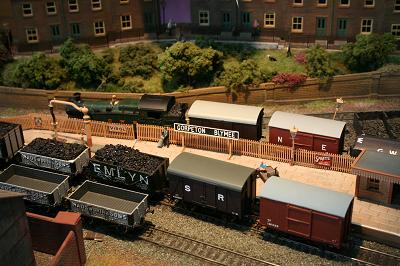 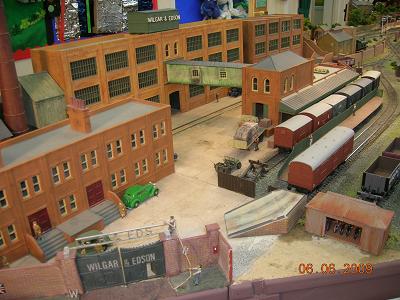 | |
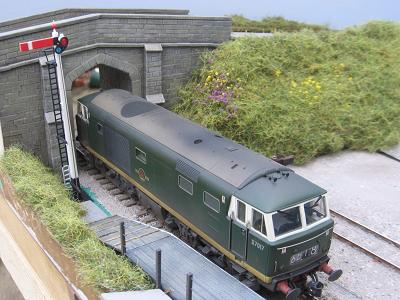 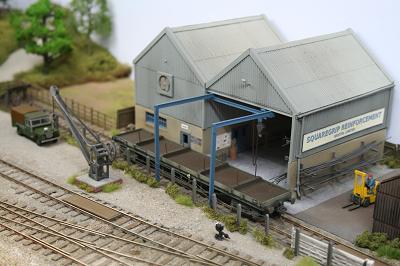 |
My main modelling interest is US rail roads but this project was conceived when Hattons announced their special run Class 14 diesel to be made for them by Heljan just after we had had an excellent day on the West Somerset Railway being pulled about by two of the same class of locomotive. "Pixash Lane" is based near Bristol and the industries modelled are loosely based on those served by local trip workings on the main Bristol to Bath ex-GWR mainline near Keynsham. Most of the buildings are scratch-built and are assumed to be on a short branch line with a halt and occasional passenger services. Most of the rolling stock is typical of the area and era - including the adjacent ex-SDJR line to Bath Green Park but we do allow ourselves plenty of licence. We normally operate using DCC - between us we can provide NCE, Lenz and Digitrax systems - and the stock is a mixture of ready to run and kits and is equipped with the US Kadee couplers which allows some hands off operation. Track is a mixture of Marcway and SMP with some Peco "off-stage". | |
Quelque Part en France The layout was originally built by Rodger Main and was called the The Salt Marsh. This was an accurate representation of part of a French metre gauge line, the Tramways de la Vendee, which ran down the west coast of France until the 1950ís. It was based on the Musee de la Petite Gare at Ile díOlonne in the Vendee region, this was a station belonging to Tramways de la Vendee. The layout is now owned by Simon Newitt and has been moved several hundred kilometres inland to somewhere in central France, rebuilt and renamed. The backscene on this layout is a modified photograph taken from our Dutch Barge on the Canal du Nivernais, near a village called Cravant, in Burgundy. Notice the vineyards on the hills in the background. The local wines (Vin Regionaux) are excellent! This layout is being used as a scenic test bed for my next Nm exhibition layout, Chatel sur Yonne. This will be based in the Yonne valley in Burgundy, our favourite part of France, with lovely scenery, great wines and wonderful canals to cruise. Scenery, Buildings and Track The scenery, buildings and road vehicles are all N Gauge scale but the track is Z Gauge (N Scale narrow gauge). This allows a relatively accurate representation of the once extensive French Metre Gauge secondary railway system. Rolling Stock Railcars (Autorails), diesels (Locotracteurs), coaches (Voiture Voyages) and wagons (Wagons Marchandises) are all to N Gauge Scale but running on Marklin Z Gauge chassis. The original German outline Z Gauge bodies are removed and replaced either by resin castings made in France or scratchbuilt bodies. | 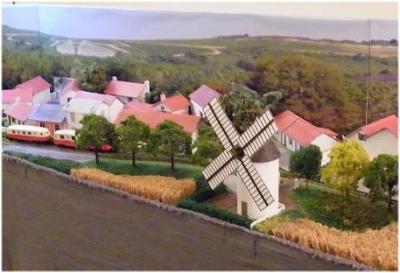 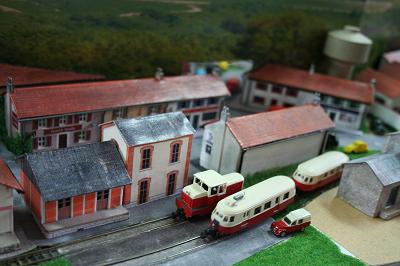 | |
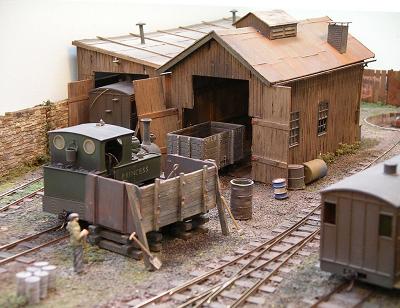 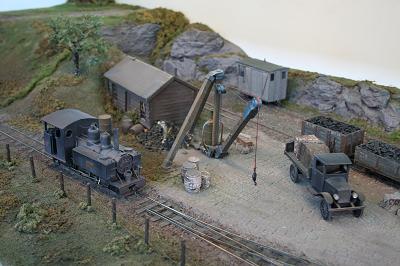 |
Rivendell was originally one end of the Twickenham and District club's narrow gauge layout but ended up stored in my loft for 10 years, until I was talked into rebuilding it. Time and an attentive squirrel partially destroyed it and one of the boards had to be scrapped. The baseboards were modified, track work re-laid, re-wired, buildings rebuilt and the scenery completely replaced. (It may have been easier to build a new layout). The neglected feeling attempts to depict narrow gauge railways in the 1930s, as bankruptcy loomed, but represents nowhere in particular. The rocks are plaster castings from rubber moulds, the wooden buildings were all scratch built, the fences made from Chinese calendars from our take-away and the trees constructed from Scalelink etchings. Note the stub points in the goods yard although they were unlikely to have been used on the prototype depicted by Rivendell. We use Kadee HO couplers, operated by electromagnets, for hands-off operation and a turntable was added to turn the Baldwin tank locomotives which in reality ran very roughly in reverse. (The Glyn Valley Tramway installed one to appease their drivers) A full history and a large number of photographs have been published in Narrow Gauge World number 48 and the British Railway Modeller Annual 2007. | |
Sandy Lane 2000 Sandy Lane, although a fictitious layout, is loosely based on Old Oak Common diesel depot on the Western Region of British Railways. The layout was built in the 1990s, but now has been brought up to date and converted to DCC control. The diesel locomotive fleet consists of ready-to-run units. All locomotives are fitted with DCC decoders, some with sound. The layout is not operated to any set sequence but is run to show the variety of diesel locomotives that have run on the various companies from year 2000 to the present day. | 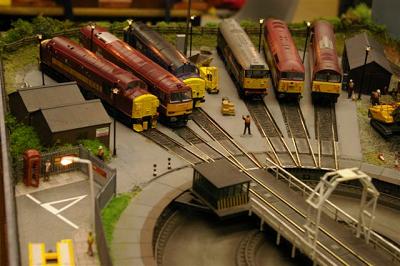 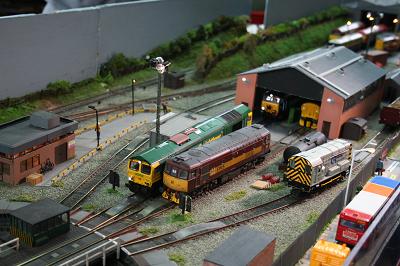 | |
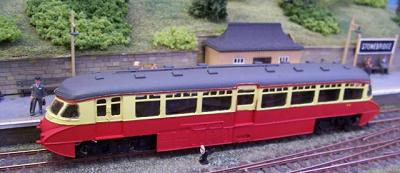 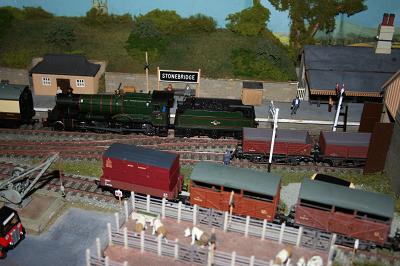 |
Stonebridge is the groupís first venture into layout construction using S.M.P. Trackwork. A quantity of ready made points and flexible track were purchases secondhand, glued onto cork and then ballasted with ĎNí gauge granite ballast. Buildings on previous layouts have been scratch-built but in order to save time, kits have been used here to good effect. The goods shed and loco shed are modified Heljan and Airfix respectively, whereas the station building was put together without any modification at all. The platform mounted signal box is also Ratio and boasts a fully fitted interior. Working signals always enhance a model railway and although only two are featured here they add another dimension to the railway scene. Perhaps in the future it may be possible to have operating ground signals. Figures bring a layout to life and these have been painted from various sources and most of the road vehicles have been altered in some way. Locos are a mixture of steam and diesel and, together with appropriate stock, trains are portrayed running in the B.R. Early 60ís period. Stonebridge is now 20 years old and was exhibited at Cheltenham for the first time in October 1987. | |
Thomas We would like to thank Trevor Hallam for looking after the Thomas Layout for many years at our exhibitions and also for refurbishing it at his expense. Unfortunately because of ill health Trevor is no longer able to continue so it was decided to offer Thomas free of charge to Hucclecote Railway Modellers on condition they bring it to all of our future exhibitions. This is the model railway where Children can become Engine Drivers on the Island of Sodor and has of course been inspired by the Reverend Audrey books. Our Thomas and Friends layout has been built for ten years now and in that time we hope it has encouraged many new railway enthusiasts to build a train set of their own. Originally it was intended as a space filler at shows so needed to be small, easy to transport and have a simple track plan, easy for small children to operate. After its first appearance it was clear this model railway would have to be included at all our exhibitions. It incorporates a tunnel, station, level crossing together with locomotive and goods facilities. Train drivers should look out for many of the popular characters; Henry, Percy, Toby, Cranky, the Troublesome Trucks, not forgetting the Sir Topham Hatt better known as the Fat Controller. The famous anthropomorphised rolling stock is mostly from the Thomas range and we are sure most of the adults and all the kids will love it. Happy Driving, but please observe the track speed limits. | 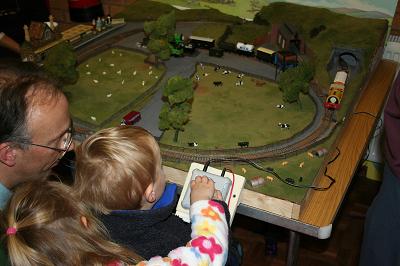 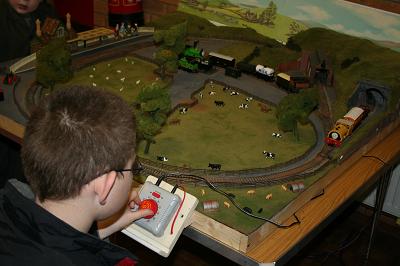 | |
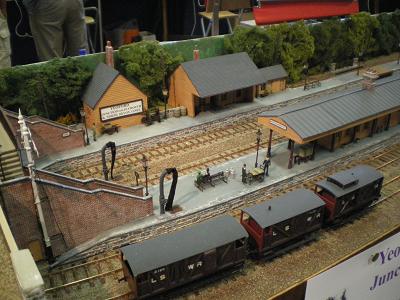 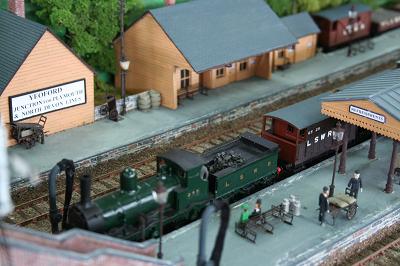 |
Yeoford, 11 miles west of Exeter, was the junction station for the LSWR lines to Plymouth and North Devon, the actual divergence being a mile to the west at Coleford Junction signal box. The wide arches of the stone over-bridges and wide spacing of the platforms were inherited from the broad gauge North Devon Railwayj. The LSWR extended the station as part of its double track main line between Waterloo and Plymouth, adding up and down bay platforms together with a small marshalling yard on the down side. During our chosen Edwardian period, we operate a timetable to include a sample of the more than 60 daily trains, including local passenger and goods trains from Exeter together with passenger trains or through coaches from Waterloo and goods trains from Nine Elms, together with stone trains from Meldon Quarry and coal from Fremington Quay. The Exeter and Torrington Travelling Post Office also runsj. Some slower trains are shunted into sidings to allow faster trains to overtake, with connections being made. As advised on the station nameboards, passengers travelling between stations on the North Devon and Plymouth lines alighted from trains on the up platform, crossed the footbridge and awaited a down train, making use of the refreshment room if time permitted. Luggage and parcels were transferred by trolley over the foot crossing. Mainly Adams and Drummond locomotives haul period trains, passengers being carried mainly in non-corridor stock but some new corridor coaches do appear. All the essential features of the curved Yeoford Junction layout are incorporated, although the length has been reduced, mainly in the sidings. Two extra bridges have been incorporated to get trains 'off-stage' behind the sidings. All bridges and buildings are hand-built, based on the North Devon and South Western structures at Yeoford. Track is hand-built using EMGS components, most rolling stock is built from kits with some scratch-built and the locomotives are powered by Portescap motors. | |
| Displays | ||
Model Bus Federation WEBSITE | NARTM (road transport) WEBSITE | |
Universal Works WEBSITE | ||
| Modelling Demonstrations | ||
| Andi Dell | Harvey Faulkner-Aston | |
| Mark Begley | Steve Adcock | |
| Trevor Hale | ||
| Trade | ||
| Castle Trains WEBSITE | Cheltenham Model Centre WEBSITE | |
| Fine Art Photographer, Paul Clarke | Iron Horse DVDs | |
| RCSW (Pre-owned) Models, Clive Reid | Rly books, timetables, photos, Stewart Blencowe WEBSITE | |
| Robbie's Rolling Stock WEBSITE | ||